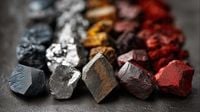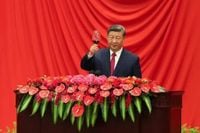Friday, October 10, 2025, was supposed to be a day of modest celebration. Investors entered the morning with cautious optimism, looking to mark the third anniversary of the bull market. But by the closing bell, Wall Street was reeling. President Donald Trump’s latest salvo in the U.S.-China trade standoff had sent shockwaves through global financial markets, wiping 2.7% off the S&P 500 and nearly 900 points from the Dow Jones Industrial Average. The culprit? A sudden escalation in tariffs and, more crucially, China’s tightening grip on rare earth metals—those vital ingredients at the heart of everything from smartphones to fighter jets.
According to Fortune, President Trump took to Truth Social on Friday, announcing that the United States was considering a “massive increase of Tariffs on Chinese products,” and that a 100% tariff on Chinese imports would take effect starting November 1, 2025. “Some very strange things are happening in China!” Trump wrote, referencing fresh Chinese export controls on rare earth elements. He accused Beijing of “a rather sinister and hostile move, to say the least,” and mused that there “seems to be no reason” to go ahead with his scheduled meeting with President Xi Jinping in South Korea later this month. The timing was anything but coincidental: China’s Ministry of Commerce had just announced a sweeping expansion of export controls on rare earths, adding five more elements—holmium, erbium, thulium, europium, and ytterbium—to its control list, along with dozens of refining technologies and pieces of equipment.
The impact was immediate. The S&P 500, which had been drifting higher for much of the week, tumbled 2.7% in a single afternoon. The Dow dropped 1.9%. Tech and green energy stocks—industries deeply reliant on rare earth minerals such as neodymium and dysprosium—bore the brunt of the selloff. Chinese technology giants Alibaba, Baidu, and JD.com plunged as much as 10%, over 8%, and more than 6% respectively. U.S. tech leaders with significant China exposure also felt the sting: Nvidia lost 4.89%, AMD dropped 7.7%, and Tesla slipped more than 5%. Meanwhile, companies tied to rare earth minerals bucked the trend. MP Materials soared by as much as 15%, USA Rare Earth jumped by 19%, and NioCorp Developments climbed 8% before paring gains.
What’s all the fuss about rare earths? As Investing News Network explained, these 17 metals are the unsung heroes of modern technology. They’re essential for manufacturing electric vehicles, wind turbines, smartphones, and sophisticated defense systems like fighter jet engines and radar. China’s dominance in this sector is staggering: it controls about 70% of global production and more than 90% of processing capacity. That’s a near-monopoly, and it’s given Beijing a powerful lever in its ongoing economic chess match with Washington.
The new Chinese measures, announced on October 9, 2025, don’t just target raw materials. They reach deeper into the supply chain, adding dozens of refining technologies and manufacturing equipment to the export control list. Foreign firms that use Chinese equipment or materials to produce rare earth materials or magnets will now need special export licenses from Beijing. Applications linked to defense industries or advanced semiconductor production—think 14-nanometer chips, memory chips with 256 layers or more, or artificial intelligence with military uses—are likely to face even tougher scrutiny or outright denial. The restrictions roll out in stages: November 8 for rare earth exports and processing technologies, and December 1 for products made with Chinese inputs.
For the United States and its allies, the message is clear: China is ready to weaponize its rare earths advantage. “It’s clear that the People’s Liberation Army is increasingly calling the shots on rare earth policy in China,” a spokesperson for NioCorp told Reuters. “That means even more difficult times both for the Pentagon and for a wide range of commercial manufacturers.”
But not everyone is caught flat-footed. Some companies have spent years preparing for this scenario. Halifax-based Ucore Rare Metals Inc., for instance, was quick to reassure markets that its flagship Louisiana Strategic Metals Complex (LA-SMC) will remain unaffected by China’s new export controls. In a statement released October 10, Ucore said it does not require or intend to use any equipment from China for its heavy rare earth separation activities in the United States. “Today’s expansion of Chinese export controls underscores why Ucore has focused its plan on North American and allied supply chains from the outset,” said Pat Ryan, P.Eng., Chairman and CEO of Ucore. “Our RapidSX™ refining technology not only produces the same rare earth products with the same quality as conventional solvent extraction, but it does so with faster throughput on a much smaller footprint, resulting in a number of economic and environmental benefits.”
Ucore’s equipment strategy for the LA-SMC project relies on components sourced from North America and allied countries—everything from displacement pumps and columns to control valves and piping. The system’s automation is powered by PLC controls and industrial computers made in the United States. Crucially, the LA-SMC project benefits from the Defense Priorities & Allocations System (DPAS) status, which means key suppliers must prioritize its orders to meet national defense and emergency preparedness requirements. This, Ucore argues, helps shield the project from global trade disruptions and long lead times for critical equipment.
China’s new export controls aren’t just about elements—they’re about control. The list now covers holmium, erbium, thulium, europium, and ytterbium, in addition to critical magnetic materials like samarium, gadolinium, terbium, and dysprosium (added in April 2025), as well as yttrium, scandium, and lutetium. Foreign companies manufacturing products with Chinese equipment or materials now need export permits, adding another layer of complexity for global supply chains.
Ucore’s vision is to help break China’s stranglehold on the rare earth supply chain. The company aims to establish processing plants in the U.S., Canada, and Alaska, and to develop the 100% Ucore-controlled Bokan-Dotson Ridge Rare Heavy REE project on Prince of Wales Island in Southeast Alaska. The company’s plan includes building sequential and modular RapidSX™ machines tailored for specific rare earth oxides, and leveraging its DPAS rating to neutralize procurement risks posed by evolving export controls.
Other North American companies are also moving to insulate themselves from Beijing’s tightening grip. Energy Fuels, which operates a uranium and rare earths facility in Utah, announced it is ramping up domestic production to counter supply risks. NioCorp, developing a rare earths mine in Nebraska, sees China’s move as a sign of the sector’s increasing militarization.
Market analysts are bracing for more volatility. Chris Zaccarelli, Chief Investment Officer for Northlight Asset Management, told Fortune that “true to form,” October is already living up to its reputation as one of the most volatile months. “The sell-off that many were expecting … has finally arrived,” he wrote, adding that while more turbulence is possible, markets could rebound later this year if the broader economy holds steady. Jamie Cox, Managing Partner for Harris Financial Group, echoed that sentiment: “October finally showed up for markets today. With major indices looking to consolidate, the tariff noise was all it took to kick it off.”
As the world watches the next moves in this high-stakes standoff, one thing is clear: the battle for rare earth supremacy is far from over, and its outcome will shape the future of technology, defense, and economic security for years to come.


